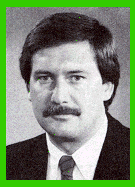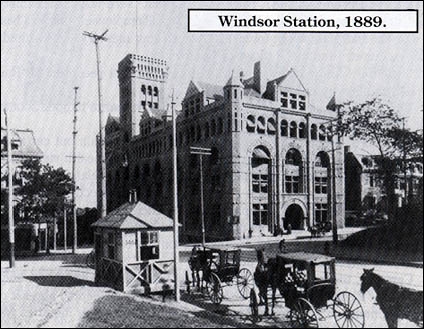Vol. 18 No. 6
June, 1988
|
Make Tomorrow Happen
|

Windsor Station
Approaches
Centennial
|

Dave Jones
|

"Beats all Creation - The New C.P.R.
Station!"
A rather immodest claim perhaps, but one that was in keeping with the ambitious spirit of the
eight-year-old Canadian Pacific Railway, and certainly that of its irrepressible president,
William Van Horne, who reputedly authored the slogan early in 1889.
The new edifice looming at the corner of Windsor and Osborn Streets (now Peel and La Gauchetiere Streets) in
Montreal had been three years in the making and was to serve as both headquarters and terminal for westbound
traffic on the recently completed railway.
During the railway's formative years, from 1881 to 1885, all of the company's resources had been focused on
completing the main line and, in keeping with the frugality of the period, Canadian Pacific directed its
operations from modest quarters located at 103 St. James Street, on the north side of Place d'Armes, beside
the Bank of Montreal.
Fashionable Residential District
Terminal facilities, known as the Quebec Gate Barracks Station, were located in the fashionable residential
district around Dalhousie Square, at the corner of Berri and Notre Dame Streets. This site had been acquired
by the company with the absorption of the western division of the Quebec, Montreal, Ottawa, and Occidental
Railway.
The QMO&O line provided the CPR with its only route out of Montreal until the completion of the Ontario
& Quebec Railway from Smiths Falls to the site of Windsor Station in 1887, which was leased to provide
access to Toronto and southern Ontario.
Now that the railway was bringing in revenue, some attention could be given to upgrading the ancillary
structures, and consequently a new, more imposing headquarters in Montreal became a priority. Coupled with
this was the need for a terminal building with a more direct route west that was afforded by the circuitous
QMO&O.
The lot on the corner of Windsor and Osborn Streets, where the station was built, had provided the setting for
an historically interesting event more than 50 years before. It once belonged to a descendant of de
Maisonneuve's lieutenant, John Picote de Ballestre, in whose garden the St. Jean Baptiste Society was founded
on 24 Jun 1834.
Founding of the St. Jean Baptiste Society
A Montreal paper, "La Minerve" describes the first meeting of the society, in part, as
follows: "The greatest gaiety reigned during the evening. The dinner was splendid. The tables were
placed in the garden of Mr. McDonnell, advocate, who had been so kind as to offer it for the occasion. The
lights suspended from the tress, the music, the fragrance of the flowers, the beauty of the locale, all lent
themselves to the charm of the spectacle".
It was at this open air banquet that Georges Etienne Cartier, then a law student and afterwards to become Sir
Georges and one of the Fathers of Confederation, is said to have sung for the first time "O Canada, mon
pays, mes, amours", verses he composed.
By the 1880's, the site was divided into several lots. Only a few houses on the south side of Osborn had to be
demolished to make way for the station.
The man chosen to design the new depot was the noted American architect, Bruce Price, who was already hard at
work on the company's mountain hotel in Banff.
No doubt Van Horne was intimately involved in the design process, being somewhat of an armchair architect
himself, and a man to whom others often deferred in matters of artistic taste.
By February 1889, the station was finished and all was in readiness. The offices were moved from Place
d'Armes to the new structure which had already become a prominent architectural landmark in Montreal.
The station changed forever the surrounding neighborhood. Where once elegant residences had stood, a number
of saloons, shops, and hotels sprang up, attracted by the new commercial environment.
The once fashionable area south of St. Antoine Street would hereafter be known as that part of the City of
Montreal "below the tracks".
This Canadian Pacific
Railway News article is copyright 1988 by the Canadian Pacific Railway and is reprinted here
with their permission. All photographs, logos, and trademarks are the property of the Canadian Pacific Railway
Company.
|
|